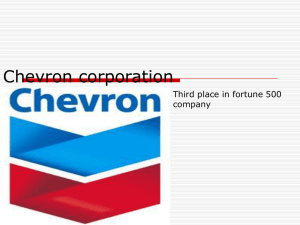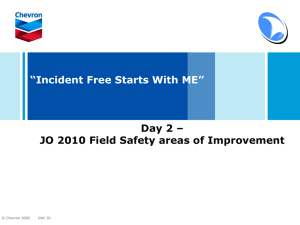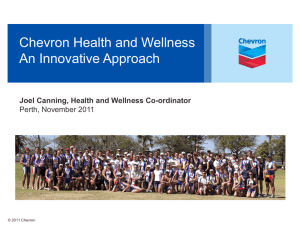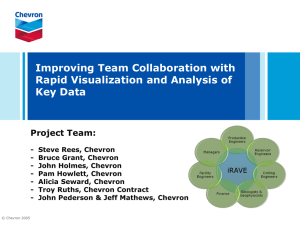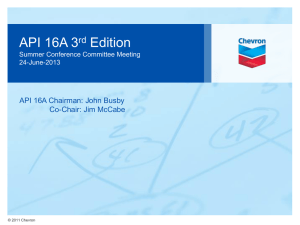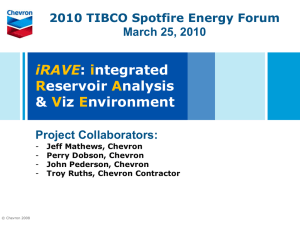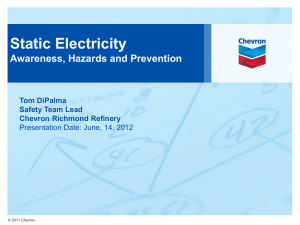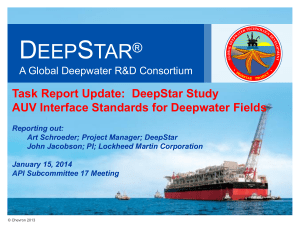LubeWatch® Oil Analysis Program Review
advertisement
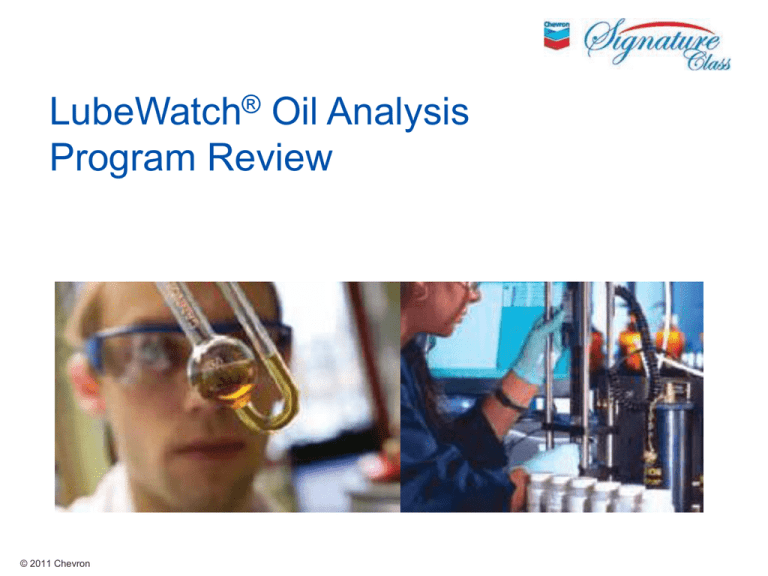
LubeWatch® Oil Analysis Program Review © 2011 Chevron Presentation Topics Introduction to Fluid Analysis Advantages of the LubeWatch® Program LubeWatch Test Packages Sampling Information HORIZON® Demonstration © 2011 Chevron 2 What is Fluid Analysis? Preventive, diagnostic testing that: Identifies contaminants and component wear Ensures lubricant integrity Identifies minor problems before they become major failures Maximizes asset reliability © 2011 Chevron 3 Benefits of Fluid Analysis Identify minor problems before they become major failures— monitoring trends in wear and contamination can help prevent catastrophic failures Extend drain intervals—fluid changes should be performed when the condition of the fluid requires them, reducing unnecessary labor costs Extend equipment life—monitoring system cleanliness can help reduce repair and replacement costs and enables you to keep equipment longer Maximize asset reliability—scheduling downtime according to your schedule can eliminate unforeseen decreases in production © 2011 Chevron 4 Features of LubeWatch® Oil Analysis Wide variety of specialized testing options Reliable interpretation of test results with actionable maintenance recommendations 24-48 hour laboratory turn-around time for most routine testing Advanced technical services including component failure and/or wear particle analysis Expert training and field support Added assurance of oil and system integrity when running an extended oil drain interval program © 2011 Chevron 5 Benefits of Promoting Fluid Analysis Builds Customer Relationships Increases Sales Engineers Lubricant Data in Field Produces Marketing Data © 2011 Chevron 6 Advantages of the LubeWatch® Oil Analysis Program © 2011 Chevron 7 Logistics and Information Management Ship your sample to the closest lab to reduce transit time and cost One phone number to call for the entire program Centralized Customer Service ensures a thorough knowledge of your program Centralized Data Analysis ensures consistent commenting and recommendations on all data from each of our laboratories One database secures data history even when samples are sent to a different lab Redundancy for disaster recovery © 2011 Chevron 8 High Quality Testing LubeWatch® Oil Analysis Program utilizes independent ISO 17025 A2LA accredited testing laboratories. The results you receive are: Accurate Repeatable Traceable All testing and analysis is supported by a documented quality system that delivers superior testing and customer service. © 2011 Chevron 9 ISO 17025 A2LA Accreditation Takes quality standard of ISO 9000 to a higher level Ensures traceability back to a standard Determines uncertainties and repeatability Is highest level of quality attainable by a laboratory backed by the most stringent accrediting body in the industry © 2011 Chevron ISO 17025 A2LA ISO 17025 Guide 25 ISO 9000 10 LubeWatch® Oil Analysis Program Test Packages © 2011 Chevron 11 C1—Basic Lubrication Purpose—monitors wear and contamination Viscosity @ 100°C Elemental Metals by ICP Water by Crackle, % © 2011 Chevron 12 C2—Diesel Crankcase Purpose—monitors wear and contamination, provides information to safely extend drains Viscosity @ 100°C Elemental Metals by ICP Water by Crackle, % Glycol (if positive, then reported in comment section) Fuel Dilution % Oxidation/Nitration Base Number © 2011 Chevron 13 C3—Natural Gas Engine Oils Purpose—monitors wear and contamination, provides information to safely extend drains Viscosity @ 40°C or 100°C Elemental Metals by ICP Water by Crackle, % (if free water is detected—run water by Karl Fischer) Oxidation/Nitration Acid Number © 2011 Chevron 14 C4—Industrial Oils Purpose—monitors wear and contamination Viscosity @ 40°C Elemental Metals by ICP Water by Crackle, % (if free water is detected—run water by Karl Fischer) Oxidation/Nitration Acid Number © 2011 Chevron 15 C4PC—Industrial Oils with Particle Count Purpose—monitors wear and contamination, fluid system cleanliness Viscosity @ 40°C Elemental Metals by ICP Water by Crackle, % (if free water is detected—run water by Karl Fischer) Oxidatio/Nitration Acid Number Particle Count with ISO rating © 2011 Chevron 16 C5—Metal Working Fluids Purpose—monitors basic properties, additive levels, fat content Viscosity @ 40°C Elemental Metals by ICP Water by Karl Fischer, % Chlorine Sulfur % Fat © 2011 Chevron 17 C6—Turbine Oils Purpose—monitors system cleanliness, wear trends, oxidative stability Viscosity @ 40°C Elemental Metals by ICP Water by Karl Fischer, % Oxidation/Nitration Particle Count with ISO Rating Water Separability RPVOT © 2011 Chevron 18 C7—Coolant Basic Conventional Purpose—monitors corrosion and inhibitor levels to determine if treatment needed pH Meter Measure Freeze Point Anti-Freeze % Boil Point Nitrite © 2011 Chevron 19 C8—Coolant Basic Extended Life Purpose—monitors corrosion and inhibitor levels to determine if treatment needed pH Meter Measure Freeze Point Anti-Freeze % Boil Point Nitrite Carboxylate Acid © 2011 Chevron 20 C9—Coolant Advanced Extended Life Purpose—monitors corrosion and inhibitor levels to determine if treatment needed, identifies formation of degradation acids pH Meter Measure Freeze Point Anti-Freeze % Boil Point Anions by Chromatography Elemental Metals by ICP Carboxylate Acid © 2011 Chevron 21 LubeWatch® Oil Analysis Program Sampling Information © 2011 Chevron 22 Sampling Best Practices Take samples: Under normal operating conditions or after shutdown while still at operating temperature At regularly scheduled intervals From the same sampling point each time © 2011 Chevron 23 Suggested Sampling Intervals Equipment Type Sampling Intervals Sampling Location Diesel Engines Monthly or at 250 hours/quarterly just prior to oil drain Through dipstick retaining tube or sample valve installed in filter return Natural Gas Engines Monthly or at 250 hours/quarterly just prior to oil drain Through oil level checkpoint, dipstick retaining tube or oil level plug Mechanical Transmission, Differentials, Final Drive/Planetary At least every 500 hours—no less than 3 times per year just prior to oil drain Through oil level plug or dipstick retaining tube Hydraulics Bi-monthly or monthly/quarterly just prior to oil drain Through oil fill port of system reservoir at mid-level Gas Turbines Monthly or at least every 500 hours Through sample valve installed upstream of the filter on the return line or out of system reservoir © 2011 Chevron 24 Suggested Sampling Intervals Equipment Type Sampling Intervals Sampling Location Steam Turbines Bi-monthly or monthly/quarterly Through sample valve installed upstream of the filter on the return line or out of system reservoir Gas/Air Compressors Monthly or at 500 hours/quarterly Through sample valve installed upstream of the filter on the return line or out of system reservoir Refrigeration Compressors Start, mid, and end of season Through sample valve installed upstream of the filter on the return line or out of system reservoir Gear and Bearing Systems Bi-monthly/quarterly Through petcock valve at exit of each gear or bearing set through system reservoir © 2011 Chevron 25 Component Registration Form Step 1 Fill out form completely and accurately Use ONLY for first-time samples or changes in unit or fluid information previously submitted Place in the black mailer with the sample jar © 2011 Chevron 26 Sample Labels Step 2 Fill out the sample jar label completely and accurately Include unit ID, type and position Include time on fluid and unit, note oil added or changed Attach label to sample jar Complete sample tracking sticker and retain © 2011 Chevron 27 Shipping Samples to the Laboratory Step 3 Take representative sample Complete and attach the return address label to the black mailer Include sample jar and component registration form, if needed, in black mailer Ship by trackable delivery service such as FedEx or UPS Track sample progress through laboratory at www.trackmysample.com © 2011 Chevron 28 Laboratory Locations LUBEWATCH FLUID ANALYSIS INDIANAPOLIS 7898 Zionsville Road Indianapolis, IN 46268 United States Phone: 866-341-0487 LUBEWATCH FLUID ANALYSIS HOUSTON 10910 W. Sam Houston Pkwy N. Suite 700 Houston, TX 77064-6314 United States Phone: 866-341-0487 © 2011 Chevron 29 Laboratory Locations LUBEWATCH FLUID ANALYSIS SALT LAKE CITY 3060 W. California Ave, Suite B Salt Lake City, UT 84104 United States Phone: 866-341-0487 LUBEWATCH FLUID ANALYSIS EDMONTON 5140 75th Street Edmonton, AB T6E 6W2 Canada Phone: 866-341-0487 © 2011 Chevron 30 POLARIS--Atlanta NOW OPEN LUBEWATCH FLUID ANALYSIS ATLANTA N. Mount Business Center 1950 Evergreen Dr., Suite 400 Duluth, GA 30096 United States Phone: 866-341-0487 © 2011 Chevron 31 Test Reports and Data Management Step 4 Get results almost immediately—FREE Keep samples on track Identify bottlenecks in sample turn-around time Influence future purchasing decisions Affect positive change in daily maintenance practices Sign up for your HORIZON account at www.chevron.polarislabs.com © 2011 Chevron 32 HORIZON® Test data available via Internet every 10 minutes Reports emailed with commenting and graphing Settings that can be set or changed by the user Several management report options available © 2011 Chevron 33 Get Started 1. Set attainable program goals 2. Determine the personnel needed to sufficiently run the program 3. Select testing appropriate to your program goals 4. Determine sampling frequencies 5. Take an active role in minimizing sample turn-around time 6. Review your reports—take action immediately 7. Manage the data © 2011 Chevron 34 Thank You Your Name Phone: 1-877-808-3750 (Your Ext.) Your Cell Fax: 1-377-808-3751 Email: yname@polarislabs.com © 2011 Chevron 35
